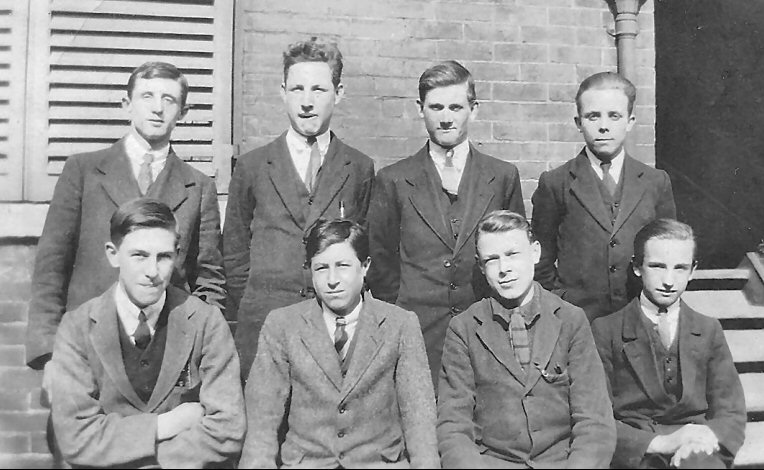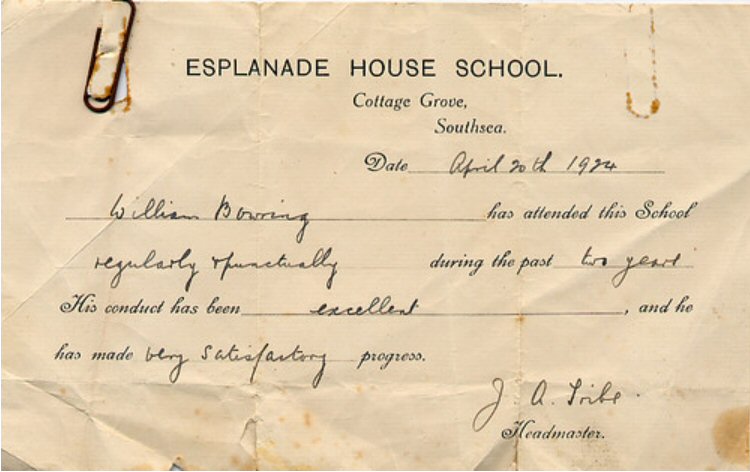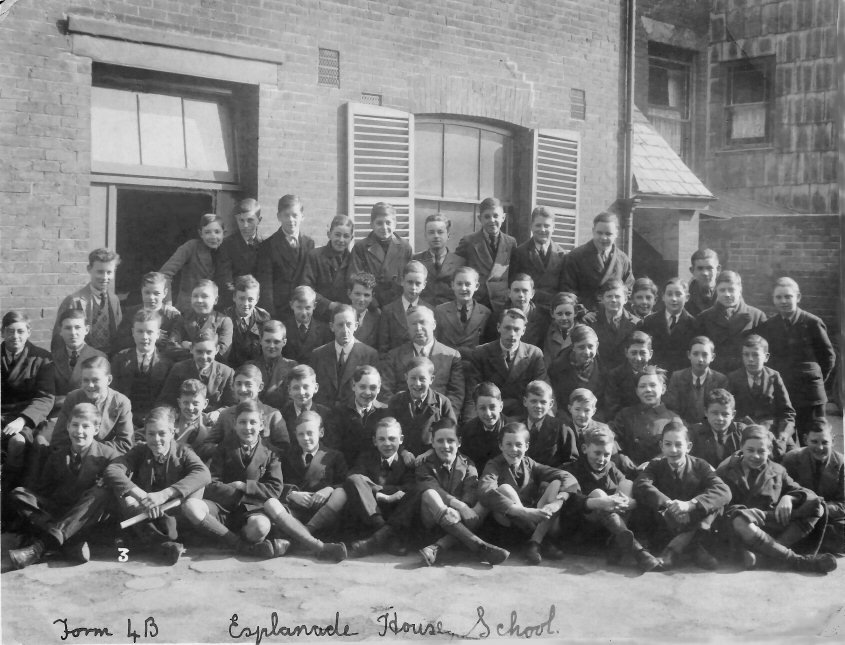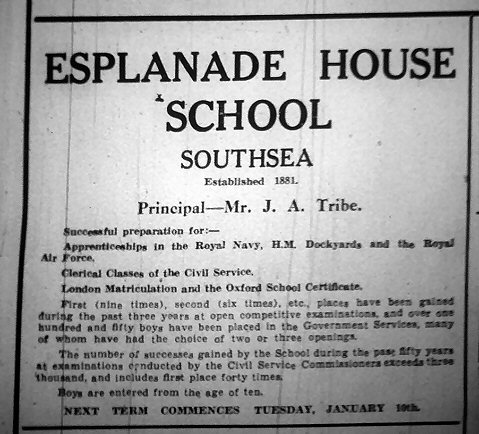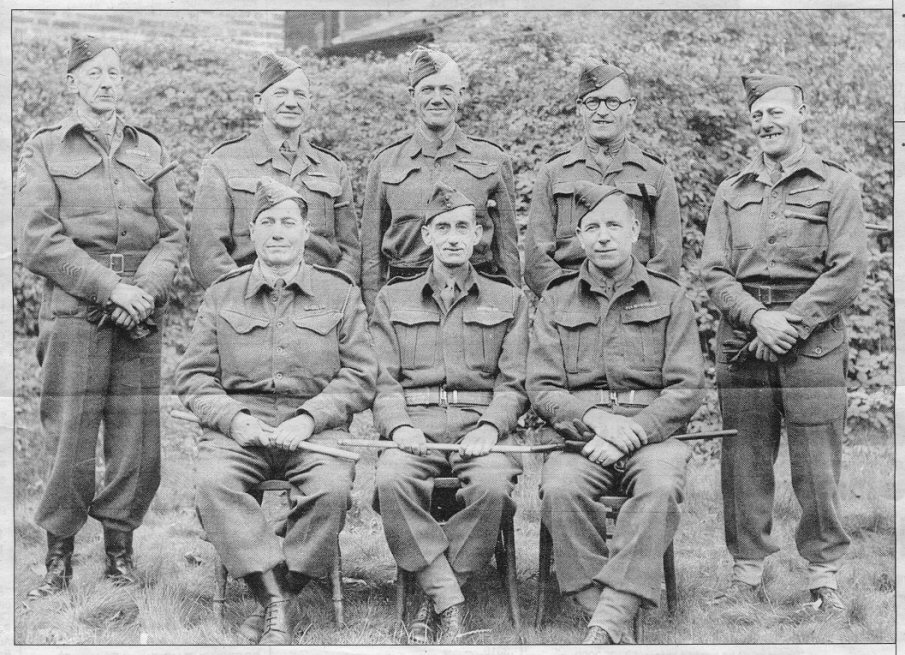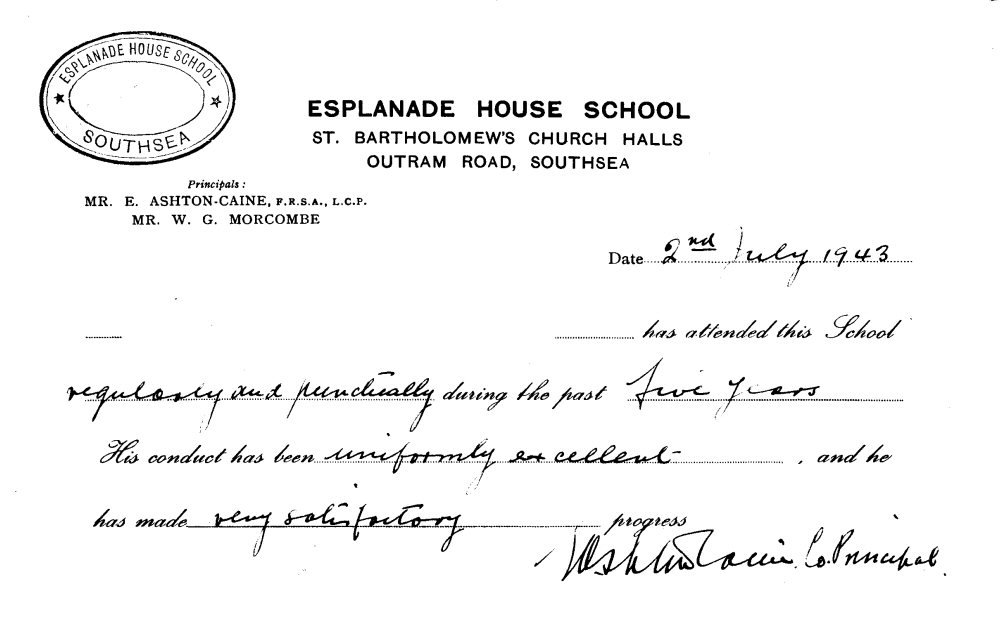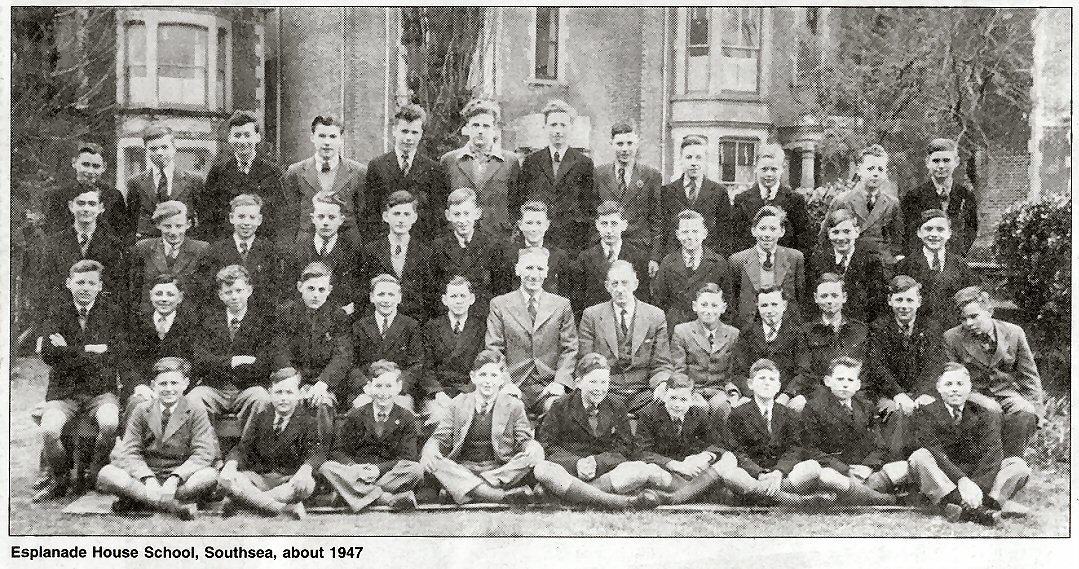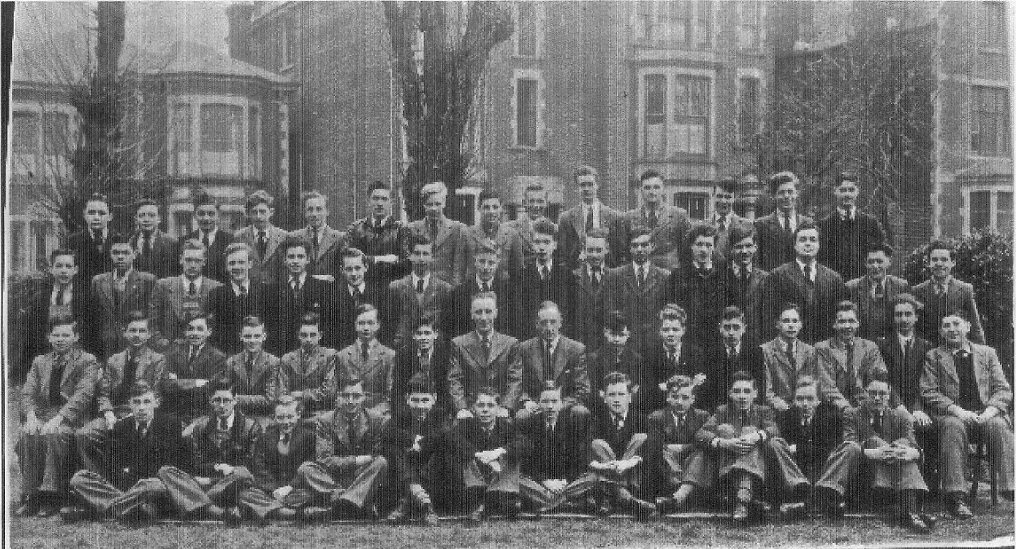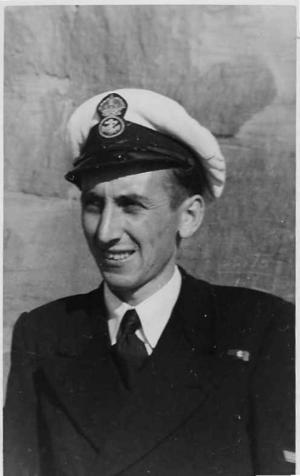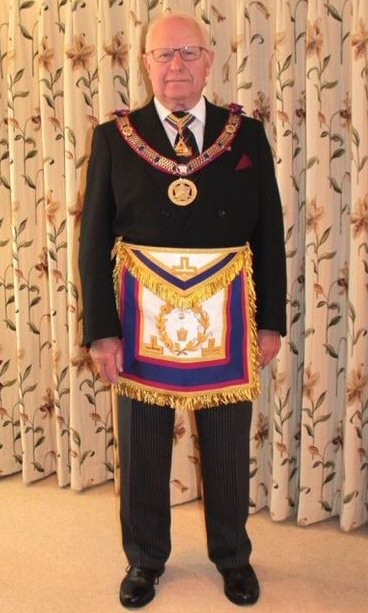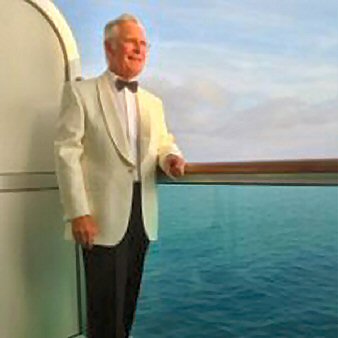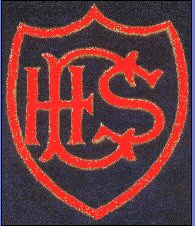

CHIVERS, also known as ESPLANADE HOUSE SCHOOLQuae Nocent Docentwe are taught by painful experience; what pains us, trains us. at Esplanade House School, Southsea. Ernest Betenson, is at the back, left of picture. On the rear of the photo the following names are written: Betenson, Carter, Williams, Stokes, Lewis, Belben, Day, Pratten |
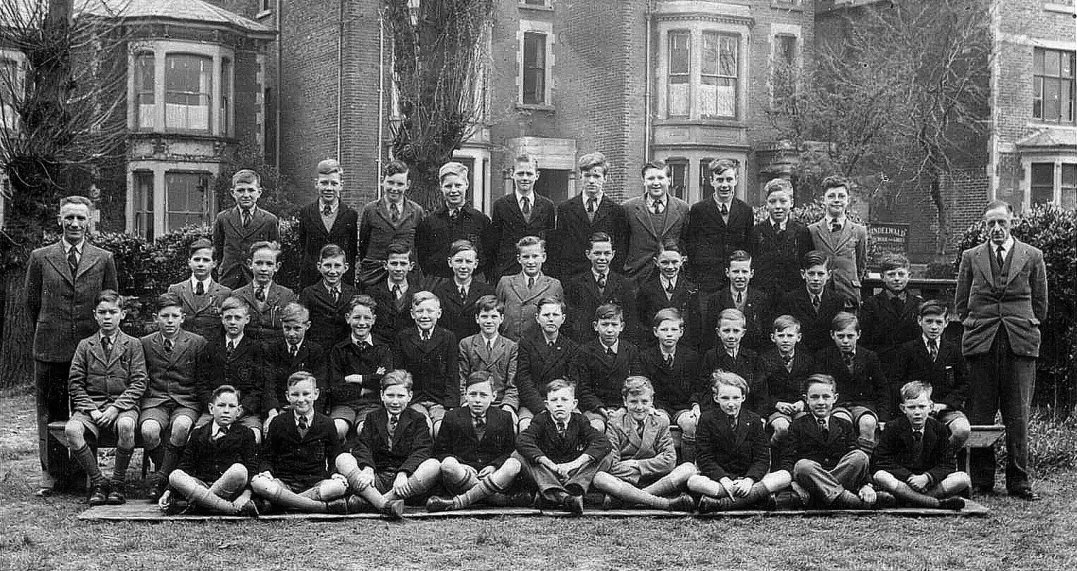
standing left Mr Wm Geo Morcombe back row;- Lyne, Brian Pavey, ???, Brian Dutton, ???, ???, Ronald Nobbs, Peter Williams, David White, Brian Wells. standing;- Lutman(1), Lutman(2), Perry, ???, ???, Hawley, ???, ???, Tony Lovett, Derek Butt, Roy Bogust. seated;- ???, Edward Mallett, David Flux, Gordon Fleming, D Pitt, Derek Cole, Courtney, Whithead, John Robinson, Michael Doherty, ???, ???, Adrian Coomber. front row;- Trevor Williams, John Mill, Derek Stallard, ???, John Schroder, David Choppen, Derek Baker, Alan Farmer(?), Startford. standing right Mr Ernest Ashton-Caine |
For some time I have wanted to produce something on the old Esplanade House School, also known as Chivers College, at Southsea. The problem was getting a picture to illustrate it. But this has been resolved by Geoffrey Pitman, of Gosport, who attended the school from 1944-48. Geoffrey also sent me a receipt relating to the term August 29 to December 20, 1944. His parents paid 4.4s. This was when Mr E Ashton-Caine and Mr WG Morcombe were the principals.
But for the background and early history of the school I have drawn upon the research and memories of former pupils Geoff Pearce, of Guildford, and Mr FE Wooden, of Fareham.
Geoff tells me that Esplanade House School was formed in 1830 by the O'Reilly brothers at St George's Square, Portsea. It moved to Lion Terrace in 1840, then Green Road around 1880, before moving to its more familiar site in Cottage Grove. William Chivers originally founded his own school in Abingdon Road, near Bradford Junction, in 1881, but transferred the school to Cottage Grove in 1904 to take over from Mr John Smythe.
This explains the two names associated with the school. Mr Wooden, a former pupil from 1937 to 1939, the year that Mr Chivers died, sent me 10 pages of his school memories. I am afraid I only have space for a few.
He recalls that the school in Cottage Grove was a large rectangular brick building set back from the road behind a high brick wall. The upstairs was a single room lit by three large windows at the front and back. Those facing Cottage Grove had the lower half covered in fine metal gauze with the words Esplanade-House-School painted in gold.
The pathway to the building sloped from the street, and any pupil using the path as a slide was sure to receive a reprimand. One was not likely to linger long in the toilets on the south-east side - they were open-roofed.
There were three classrooms, two downstairs, the smallest of which was simply called the Little Room to hold 30 of the youngest and new entrants. Next to this was the Dockyard Room, accommodating 40-plus pupils, while the Upstairs Room held around 80.
The desk furniture was of well-worn wood and covered in the initials of previous occupants, and the wood benches polished by the seats of many boys to leave knots protruding uncomfortably.
School books, purchased by parents, were kept in desks with lift-up lids with each pupil's heavy leather satchel. The school uniform comprised a grey jacket, trousers and cap, a white shirt, and a red and black horizontal-striped tie. The cap and blazer badges had the initials EHS, and the entire ensemble was obtained from an outfitters in Elm Grove. The teachers in Mr Wooden's time under the principal, Mr John Alexander Tribe (known as Josser), were Mr William George Morcombe (Moggy), Mr Ernest Ashton Caine (Caner), Mr Walter French (Beery), and Mr Carnell. The first three were very experienced and capable of teaching any of the subjects on the curriculum at any level, and frequently deputised for each other.
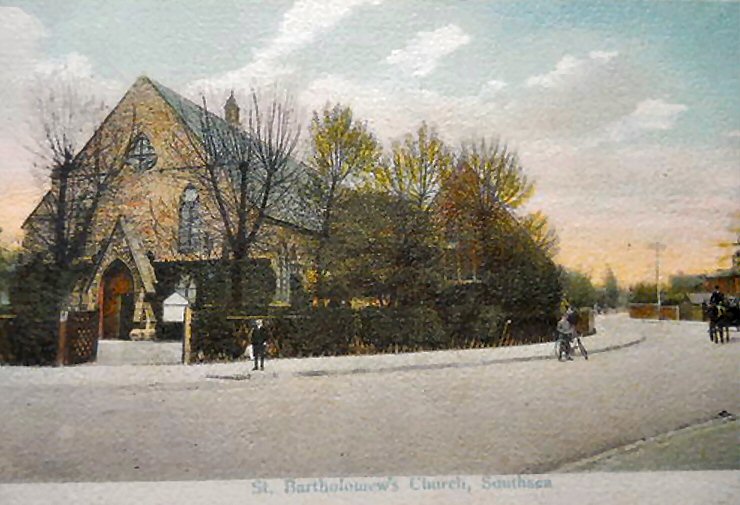
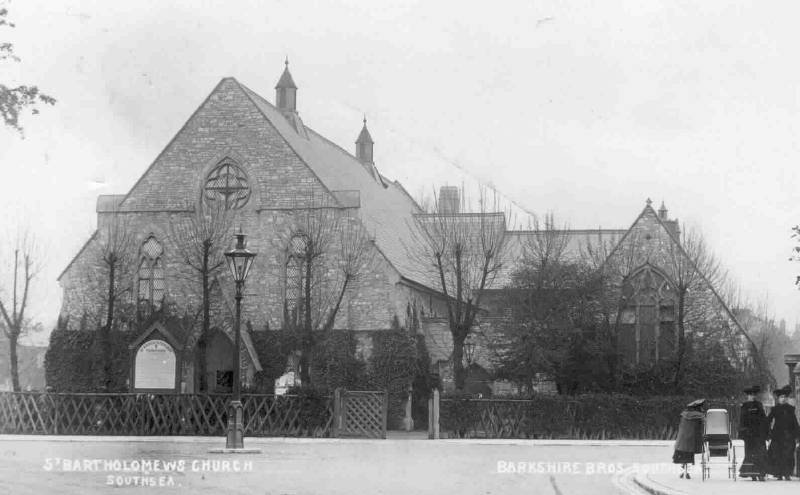
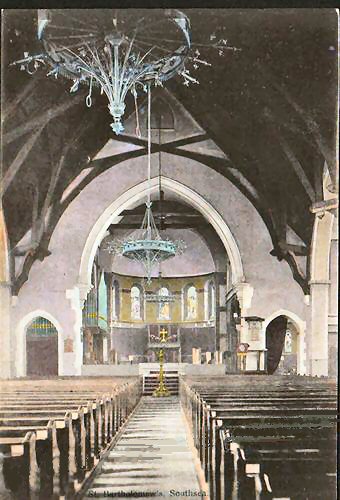
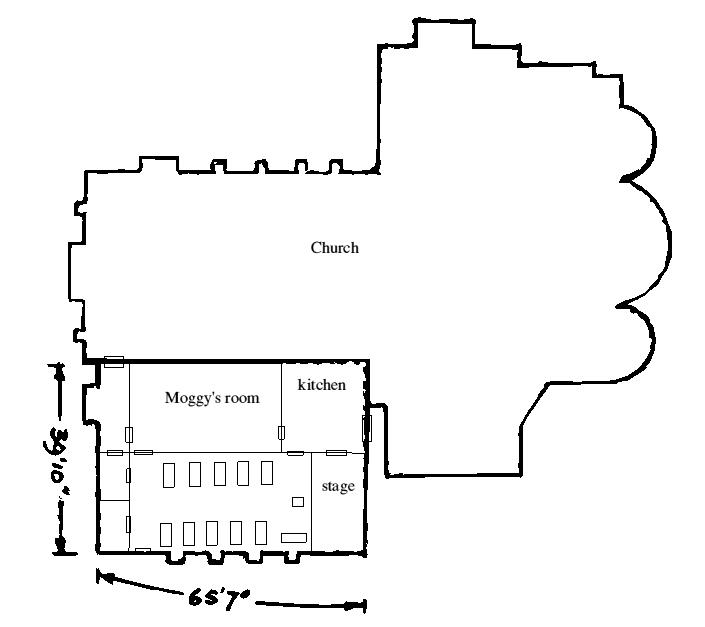
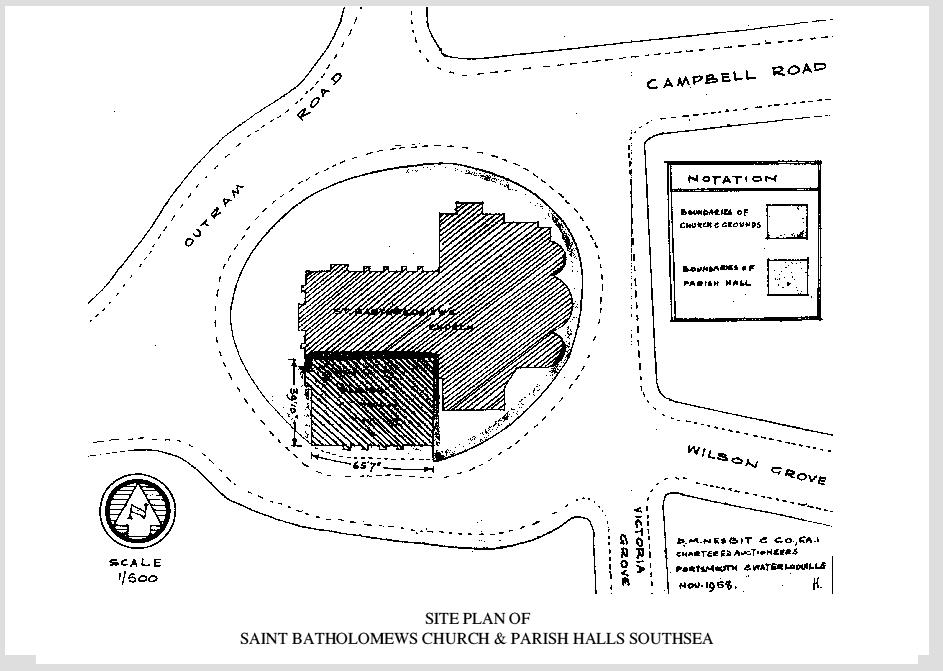
. Having begun at Cottage Grove, it moved to Outram Road after being destroyed by incendiaries. The teachers were Mr Ashton-Caine and Mr Morcombe and the fees were three guineas ( 3.15) per term plus one shilling (5p) for coal in the winter term. Ernest Aston Caine died age 72 in 1959.
 Research by Geoff Pearce
Research by Geoff Pearce
CHIVERS/ESPLANADE HOUSE SCHOOL,
SOUTHSEA
1897
Mr George Henry Lane, carpenter, lived at 105 Cottage Grove.
Havelock House School, 14, Wilson Grove, Southsea. No William S Chivers, but
William Chivers at 8 Central Street, and William Chivers at 57 Hope Street.
"Eastman.s Royal Naval Academy" part of Buckland Place Academy.
There was no 88 Laburnam Grove listed; presumably didn't exist.
1900 - 105/19a Cottage Grove George Henry Lane, carpenter.
Havelock House School, 14, Wilson Grove, Southsea.
William S Chivers, 88 Laburnham Grove
1902 - 105/19a Cottage Grove George Henry Lane, carpenter
BUCKINGHAM PLACE ACADEMY - No 26 -(C H Napier principal, William Chivers S Abingdon (sic), 88 Laburnam Grove, on staff)
4 Cottage Grove listed as Cooke Hy Jn net Surgeon Board School
1903 - SMITH ROYAL SERVICE SCHOOL (Rev E Albary Clarke MA principal)
Cottage Grove. Havelock House School, 14, Wilson Grove (Misses Tilly, principals)
BUCKINGHAM PLACE ACADEMY CALDWELL MISSES LADIES'SCHOOL, Class for Boys - limited No. boarders received - William S Chivers Abingdon Road.
(88 Laburnam Grove)
1904 - ESPLANADE HOUSE SCHOOL (William S Chivers LCP registered teacher,
Board of Education, principal, 88 Laburnham Grove)
1906 - ESPLANADE HOUSE SCHOOL - as above - east side of Cottage Grove
George Henry Lane still at No 105
1908 - ESPLANADE HOUSE SCHOOL - as above
Harold Chapman Palmer at No. 105.
1910-11 - ESPLANADE HOUSE SCHOOL, - as above
1912-13 - ESPLANADE HOUSE SCHOOL, - as above
1914 - ESPLANADE HOUSE SCHOOL, - as above
Other teachers listed under (apparent) same heading:
Misses Green, 6, Derby Road.
Misses J&E Hall, 32 Britannia Road.
Miss Johnson, 28 Albany Road.
Miss E Knight, Apsley House, Auckland Road.
Miss L Lane, 66, Oriel Road.
Ernest Edward Cain lived at 92, Frensham Road - can't be Ernest Ashton-Caine!
 1916 - ESPLANADE HOUSE SCHOOL - as above, but teachers (apparently) listed:
1916 - ESPLANADE HOUSE SCHOOL - as above, but teachers (apparently) listed:
Misses Green, 6, Derby Road.
Misses J&E Hall, 32 Britannia Road.
Miss Johnson, 28 Albany Road.
1918 - ESPLANADE HOUSE SCHOOL - as above
John A Tribe, 159, Essex Road, Eastney.
1920 - Byculla school for Daughters of Officers & Professional men, Cottage Grove?
William Chivers, Esplanade House, Cottage Grove. - 88 Laburnham Grove.
Mrs Butler lived at 55, Chelsea Road.
No Sunningdale Road listed - couldn't have been built!
1921 - ESPLANADE HOUSE SCHOOL
1922 - ESPLANADE HOUSE SCHOOL - as above, with William S Chivers
1923 - ESPLANADE HOUSE SCHOOL - as above, with William S Chivers
1924 - ESPLANADE HOUSE SCHOOL (John A Tribe.principal - 159 Essex Road)
1925 - ESPLANADE HOUSE SCHOOL (John A Tribe.principal - 159 Essex Road)
William S Chivers 88 Laburnum Grove
Sunningdale Road not listed.
14, Wilson Grove - Havelock House School seems to have disappeared!
Mr Ernest Aston-Caine, 55, Chelsea Road.
1929-30 - ESPLANADE HOUSE SCHOOL - John A Tribe - as above
36, Cottage Grove - "The Southern Progressive School"
Misses Green, 6, Derby Road. - Buckland Park Academy still about.
William S Chivers, 88, Laburnum Grove.
Mr Ernest Ashton-Caine, 55, Chelsea Road, Southsea.
Mr William Geo Morcombe, Way Down, Sunningdale Road, Copnor.
1931-32 - ESPLANADE HOUSE SCHOOL - John A Tribe - as above
88, Laburnum Grove - Mrs Magee - ie William S Chivers gone.
Mr Ernest Ashton-Caine, 55, Chelsea Road, Southsea.
Mr William Geo Morcombe, Way Down, Sunningdale Road, Copnor.
Mr Carnell, a teacher at the school in 1938. No first name, can't pinpoint!.
1934-35 - ESPLANADE HOUSE SCHOOL - (J A Tribe, 159 Essex Road, Eastney, principal;
Reference to 88 Laburnum Road missing.
Mr Ernest Ashton-Caine, LCP MRIPHH, 55, Chelsea Road, Southsea
Mr William Geo Morcombe, 62, Sunningdale Road, Copnor
1939-40 - ESPLANADE HOUSE SCHOOL (J A Tribe, principal, Life Member College of Preceptors, Member Royal Society of Teachers, 159 Essex Road, Eastney)
88, Laburnam Grove - William Norcott Rundle.
Mr Ernest Ashton-Caine, LCP MRIPHH, 55, Chelsea Road, Southsea
Mr William Geo Morcombe, 62, Sunningdale Road, Copnor
1940 - ESPLANADE HOUSE SCHOOL - Cottage Road bombed.
1946 - ESPLANADE HOUSE SCHOOL (principals Mr E Ashton-Caine FRSA LCP; Mr W E Morcombe - Preparation for London Matriculation, Oxford School Certificate, Civil Service, Royal Navy, Army, Air Force. Prospectus on application, St Bartholomews Church Halls, Outram Road, Southsea)
John A Tribe, 159 Essex Road, Eastney.
John A Tribe - "gone" - at least, from Kellys Directory.
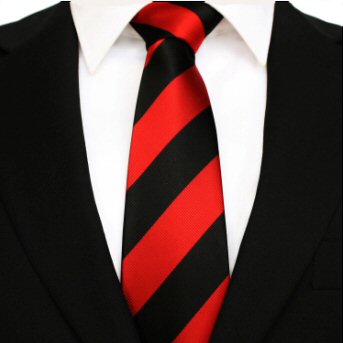 1951 - ESPLANADE HOUSE SCHOOL - as above
1951 - ESPLANADE HOUSE SCHOOL - as above
159, Essex Road, Eastney - Harold Geo Durman
Mr Ernest Ashton-Caine, LCP MRIPHH, 55, Chelsea Road, Southsea
Mr William Geo Morcombe, 62, Sunningdale Road, Copnor
1953 ESPLANADE HOUSE SCHOOL - as above
1958 - ESPLANADE HOUSE SCHOOL - as above - believed moved to Buckland
Congregational Church Halls, Queens Road, Buckland in September. Geo Smith took
over from 'Charlie'. (In Library copy someone hand-changed address.)
Mr/Mrs Ernest Ashton-Caine, LCP MRIPHH, 55, Chelsea Road, Southsea
Mr William Geo Morcombe, 62, Sunningdale Road, Copnor
1960 - ESPLANADE HOUSE SCHOOL - Morcombe & Smith at Buckland.
Mrs Ashton-Caine, 55 Chelsea Road, Southsea
Mr William Geo Morcombe, 62, Sunningdale Road, Copnor
1964 - ESPLANADE HOUSE SCHOOL - as above. (No sign of Tribe).
W G Morcombe MCP & G G Smith BSc.
Mrs Ashton-Caine, 55 Chelsea Road, Southsea
Mr William Geo Morcombe MCP, 62, Sunningdale Road, Copnor
1969 - ESPLANADE HOUSE SCHOOL - Buckland - last mention of school
Mr William Geo Morcombe, 62, Sunningdale Road, Copnor
1973 - Mr William Geo Morcombe, 62, Sunningdale Road, Copnor
1975 - Mr William Geo Morcombe, 62, Sunningdale Road, Copnor
1976 - Mr William Geo Morcombe, 62, Sunningdale Road, Copnor
THE HISTORY OF CHIVERS
The founder of EHS was William S Chivers, of 88, Laburnum Grove, who was at this address in 1900 (and
possibly before) and was there sometime between 1930 and 1935, when he presumably died. (in 1935 there is no-one registered as living at that address).
He appears to have taught boys at BUCKINGHAM PLACE ACADEMY at the turn of the century: Caldwell Misses Ladies School Class for Boys ("limited number of borders received"), Abingdon Road. The first reference to EHS in Cottage Grove is in 1904, with W S Chivers as principal. In 1914 he is listed as principal with (apparently) 5 female teachers, which reduced to three by 1916! One of these ladies a "Misses Green" of 6, Derby Road, appears on the role in 1930, when John A Tribe had taken over as principal (sometime between 1922 and 1925). His address was159, Essex Road, Eastney.
The first reference I can find to Ernest Ashton-Caine and William Geo Morcombe is (so far) 1930 - might be earlier. Charlie at 55 Chelsea Road, where he stayed to 1959, Mog at "Way Down", Sunningdale Road, and later No. 62.
The "Girls' School, round the corner" I remembered, I thought must have been Havelock House School, 14, Wilson Grove, there in 1897. Unfortunately, it appears to have "disappeared" in the early 1920s. So, I'm none the wiser.
School was originally located next to Grove Middle School, Cottage Grove, in a 'proper' building.
It was bombed in 1940 (probably August 24th?), when they moved to St Barts.
George Pincott was there 1939-43; Len Trayes 1940-43.
St Bartholomews was the permanent replacement for famous "The Crinoline Church" of 1858, and built of Kentish ragstone in 1861. The hall was built in the Romanesque style in 1897. (info. in 'Portsea Island Churches'.
St Bartholomews was demolished because the parish was combined with that of "Holy Spirit", which had been rebuilt, following being bombed during the War.
Chiver's College was an affectionate name, after the founder of the school: Jo Chivers.
School founded turn of the century. (1914?)
1948
Ernest Ashton-Caine 55, Chelsea Road Southsea
Wm Geo Morcombe 62, Sunningdale Road Copnor.
School at St Bartholomews Church Hall Outram Road Southsea.
1960
Wm Geo Morcombe 62, Sunningdale Road Copnor.
Geo G Smith 46 Lonsdale Ave Cosham
Mrs Ashton-Caine 55 Chelsea Road, but she was not connected with school,
perhaps he had died?
School at Buckland Cong Church Hall, Queens Road Buckland.
1976
Wm Geo Morcombe 62, Sunningdale Road Copnor.
No trace Caines or Smith.
no advert for EHS, (I think it finished mid 1960's?)
London Road North End
Cottage Grove
St Barts Halls
St Mary's institute.
"Esplanade House School" was started in 1830 by William and J O'Reilly at
66, St. George's Square, although it was not until 1840 that they move to
Esplanade House in Lion Terrace (off Queens Road), where the school stayed
for about 40 years. In 1864 the school turned its attention to Naval and
Civil Service entrance examinations.
Edward Bell was Mr Reilly's assistant from 1856, became principal in 1864
for nine years. In 1874 John Smyth took over as principal until 1904. During
his reign the school moved to 38, Green Road. (The house is still there, and
I took a photo of it on Saturday!) and then to Cottage Grove. It is not
clear when to school moved to Cottage Grove, or if the school was
'purpose-built'.
William Smith Chivers (I have a photograph of him) opened Chiver's School (a
separate establishment) in Abingdon Road in 1881. This road was near
Bradford Junction, and no longer exists, as it was cleared to build new
roads in the area about 20 years ago. He also prepared boys for Civil
Service and Dockyards entrance exams, with considerable success, apparently.
In 1904 Mr Chivers transferred his school to 'Esplanade House' in Cottage
Grove , to a building which appears on the 1898 Ordnance survey map at the
end of the garden of Somers House, but not on the 1872 map. This is probably
why the school had an 'official' and unofficial' name! Did Chivers move his
school to EHS, or take over EHS? - if you see what I mean.
Mr Chivers retired in 1918 or 1920, and died in 1937. His assistant, John
(Josh) Tribe took over until 1941, when the school was gutted by
inceniaries. ("Josser" Tribe was a former pupil, who, at 17 was the
ginger-haired senior boy).
The rest, as they say, is history. The school moved to Queen's Road, on the
death of Ashton-Caine in 1959. Mog had been teaching at the school from
about 1920. An Association of Old Chivernians was formed in about 1962, and
tried to save the school in 1965, when it had moved to the St. Mary's
Institute in Fratton Road. The endeavour failed, however, and the demise of
the school in the Evening News in September, 1966. The School Motto was,
apparently "Quae nocent docent" (What pains us, trains us).
"Esplanade House School" was founded by William and J O'Reilly at 66, St George's Square in 1830, although they moved to Esplanade House at Lion Terrace (off Queen's Road) in 1840. The school moved again to 38 Green Road in about 1880, in what appears from old maps to have been a large house called "Somers House", which included gardens upon which the Cottage Grove school was built. The O'Reillys ran the school until 1864, when Edward Bell took over, and from 1873 John Smyth was principal until William Smith Chivers took over in the Cottage Grove building.
William Smith Chivers started Chivers School in Abingdon Road in 1881, and moved his school to Cottage Grove in 1904. It seems therefore that the two schools combined to form one, but could not quite make up its mind whether to be "Chivers School" or "Esplanade House School".!!!
I do not know when the Cottage Grove building was built, but it appears on the 1898 Ordnance survey map, and in 1903 seems listed as the "Smyth Royal Service School" with Rev. E Albany Clarke as principal - although EHS was still at 38 Green Road.
By 1910 Frank J Privett, builder, occupied the site next to the school (as you indicated in your letter) and the original number 38 appears to have been demolished to make way for a row of houses, which still occupy the site. The numbers between Smith Lane and Cottage Grove changing from 30-38 at the turn of the century, to 30 - 50 by 1911!
Mr Chivers retired about 1920, and John "Josser" Tribe took over. It seems "Joss" was a senior ("a ginger-haired lad") boy at the school in the early days who, at 17, taught the younger boys, whilst Mr Chivers taught the older boys. When Mr Tribe became established as the official deputy, he grew a "bristling moustache" to "match his dignity".
William Smith Chivers died in 1937. I have a number of anecdotes from the old days, one involving Messrs Bedford and French, who both taught physics. It appears the boys used to play one off against the other. I assume this was before your time.
Geoff Pearce
1830-1840- School started at 66 St Georges Square by William and J O-Reilly.
1840 - School moved to ESPLANADE HOUSE, Lion Terrace
1864 - Edward Bell becomes principal.
1873 - John Smyth, principal, ESPLANADE HOUSE, Lion Terrace.
1880-1897- ESPLANADE HOUSE SCHOOL, 38, Green Road. John Smyth
William Smith Chivers, Chivers (day) School, Abingdon Road.
"John Tribe", 132 Upper Grigg Street ('86) 7, St Paul's Rd ('92) 7 Chelsea Rd ('97)
1900-1902- William Smith Chivers, 88 Laburnham Grove: Chivers School, Abingdon Road
(Between Smith Lane and Cottage Grove house numbers were 30,32 & 38, which indicates that the school occupied Somers House, and owned the land on which the Cottage Grove building was built. "The Kings Arms" between Cottage Grove and Somers Street was number 42 at this time).
1903 - SMYTH ROYAL SERVICE SCHOOL (Rev E Albary Clarke MA) Cottage Grove
appears to be occupying the "EHS" building.
William S Chivers Abingdon Road Day School.(88 Laburnam Grove)
1909-1911- The old Chivers School building in Abingdon Road appears to have become "Abingdon Hall", with G Hinton, proprietor, used by St Peter's Church Mission and the Christadelphian Lecture Room.
Frank J Privett is next door to EHS. ("Novadene")
Numbers from Smith Lane are now 30, 30A, 32/34/36 - no 38 '09/10, but '10/11 building occupied by a number of people, indicating division into flats? Between Cottage Grove and Somers Street we have number 50 and 52, "The Kings Arms" being the latter.
1904-1921- ESPLANADE HOUSE SCHOOL (William S Chivers LCP registered teacher,
Board of Education, principal, 88 Laburnham Grove)
Ernest Edward Cain at 92, Frensham Lane.(1908-11)
"Mrs Morcombe" at 42 Carnarvon Road.
"Ernest Edward Cain" 92, Frensham Rd
(John Brown at 55, Chelsea Road; Mrs Butler 1920).
John A Tribe, 159, Essex Road, Eastney.
1920 - "Abingdon Hall" gone - now a corset factory?
Between Smith Lane and Cottage Grove numbers consecutive 30 to 50, with 50A
other side of road, 54, and 56 being "Kings Arms".
1922-1923- ESPLANADE HOUSE SCHOOL - as above, with William S Chivers
"Ernest Edward Cain" - 111 Devonshire Avenue
1924-1925- ESPLANADE HOUSE SCHOOL (John A Tribe.principal - 159 Essex Road)
William S Chivers 88 Laburnum Grove
Mr Ernest Ashton-Caine, 55, Chelsea Road, Southsea - (Sunningdale Road not listed)
1929-30 - ESPLANADE HOUSE SCHOOL - John A Tribe - as above
William S Chivers, 88, Laburnum Grove.
Mr Ernest Ashton-Caine, 55, Chelsea Road, Southsea.
Mr William Geo Morcombe, Way Down, Sunningdale Road, Copnor.
1931-32 - ESPLANADE HOUSE SCHOOL - John A Tribe - as above
88, Laburnum Grove - Mrs Magee
Mr Ernest Ashton-Caine, 55, Chelsea Road, Southsea.
Mr William Geo Morcombe, Way Down, Sunningdale Road, Copnor.
1934-40 - ESPLANADE HOUSE SCHOOL (J A Tribe, principal, Life Member College of Preceptors, Member Royal Society of Teachers, 159 Essex Road, Eastney)
88, Laburnam Grove - William Norcott Rundle.
Mr Ernest Ashton-Caine, LCP MRIPHH, 55, Chelsea Road, Southsea
Mr William Geo Morcombe, 62, Sunningdale Road, Copnor
1938 - WILLIAM SMITH CHIVERS DIES.
1941 - ESPLANADE HOUSE SCHOOL - Cottage Road school gutted by incendiary.
1946-1954- ESPLANADE HOUSE SCHOOL (principals Mr E Ashton-Caine FRSA LCP; Mr
W E Morcombe - Preparation for London Matriculation, Oxford School Certificate, Civil Service, Royal Navy, Army, Air Force. Prospectus on application, St Bartholomews Church Halls, Outram Road, Southsea)
Mr Ernest Ashton-Caine, LCP MRIPHH, 55, Chelsea Road, Southsea
Mr William Geo Morcombe, 62, Sunningdale Road, Copnor
John A Tribe, 159 Essex Road, Eastney - (not there by 1948-49).
1955-1958- September '55 to July '58- at EHS with Brian Maxwell.
Wm Maxwell, 221A Devonshire Avenue (Brian Maxwell's father)
Rev Jn Douglas Beloe, rector, Holy Spirit - 26, Victoria Grove. (1948-9 also)
1959 - ESPLANADE HOUSE SCHOOL - moved to Buckland
Congregational Church Halls, Queens Road, Buckland. Geo Smith took
over from 'Charlie', who had died in 1959.
Mrs Ernest Ashton-Caine, LCP MRIPHH, 55, Chelsea Road, Southsea (there 1966)
Mr William Geo Morcombe, 62, Sunningdale Road, Copnor
1966 - ESPLANADE HOUSE SCHOOL/ CHIVERS SCHOOL, CLOSES DOWN
(Now at St Mary's Church, Fratton)
1976 - Mr William Geo Morcombe, 62, Sunningdale Road, Copnor
I decided to find out as much as I could about our Alma Mater: Esplanade House School (or Chiver's College), which we both attended in the mid-1950s. It is true that this latent enthusiasm has been very catching, but I deny that it has become a disease!
When we were at the school, it was in the church halls of St Bartholomew's Church in Outram Road, where it had re-located after the old school building in Cottage Grove had been gutted by incendiary bombs in 1941. The school moved to Queen's Road in 1959, when St Bartholomews was pulled down and houses built on the site. It moved later to St Mary's Institute, where it finally closed down in 1966. I understand that an "Old Chivernians" association was formed in 1962, but I have no idea how long it lasted - or even if it still exists!
During my three years at the school all I recall of its history was that "it had been bombed during the war". There were two teachers when I was there: Mr Ernest Ashton-Caine (principal until he died in 1959) and William 'Mog' Morcombe. They were both very good teachers, though by today's standards, somewhat unconventional. There was a mixture of casualness and strictness, with a liberal use of the cane. The methods used however, proved to be very effective. The text books all dated from the turn of the century, and had presumably been in constant use since then! Certain memories are quite vivid. Mr Ashton-Caine used to tell us that the Kaiser "Had this great army, which he wished to try out", and woe betide anyone who had not done his homework - Mr 'Mog' Morcombe: "How long did you spend on your homework last night?". "About three hours, sir". "About three hours is about two hours, about two hours is about one hour---etc!" Swish! swish!
Despite the discipline, we still took chances. For example, the end-of-term concert in the large hall had us "secretly" smoking when lights were down, and "hiding" the offending weeds under the seats when the lights went up. Strangely, we were not challenged if for no other reason than the smell which must have resulted.
Esplanade House School was formed in 1830 by the O'Reilly brothers at 66, St George's Square. It was not until 1840, however, that it moved to Esplanade House in Lion Terrace, off Queens Road., where one assumes the school derived its name. Edward Bell became principal in 1864, and in 1873 John Smyth took over until 1904, during which time the school moved to 38, Green Road (about 1880), and later to the Cottage Grove building (built on the end of the garden to Somers House) right next to a pair of semi-detatched house, which are still there.
William Smith Chivers formed his own school (Chiver's School) in 1881 in Abingdon Road. This was near Bradford junction, although the Road now no longer exists. Mr Chivers transferred his school to Cottage Grove in 1904, taking over from John Smyth. This probably explains why the school was 'officially' Esplanade House School, but also called 'Chiver's College'. John Tribe became principal in about 1920, and remained until 1941. William Chivers died in 1937.
In recalling my time at the school allowances have been made for the fact that the "not-so-happy-memories" tend to get blotted out over the years. Nevertheless, I owe a lot to the school and have it to thank for my education and subsequent career. Over the years Chiver's School played an important part in the history of Portsmouth, and I am proud to have been part of it. I would still like to find out more about the school and be pleased to hear from former pupils who have a tale to tell.
Geoff Pearce
THE HISORY OF CHIVERS
The founder of EHS was William S Chivers, of 88, Laburnum Grove, who was at this address in 1900 (and
possibly before) and was there sometime between 1930 and 1935, when he presumably died. (in 1935 there is no-one registered as living at that address).
He appears to have taught boys at BUCKINGHAM PLACE ACADEMY at the turn of the century: Caldwell Misses Ladies School Class for Boys ("limited number of borders received"), Abingdon Road. The first reference to EHS in Cottage Grove is in 1904, with W S Chivers as principal. In 1914 he is listed as principal with (apparently) 5 female teachers, which reduced to three by 1916! One of these ladies a "Misses Green" of 6, Derby Road, appears on the role in 1930, when John A Tribe had taken over as principal (sometime between 1922 and 1925). His address was159, Essex Road, Eastney.
The first reference I can find to Ernest Ashton-Caine and William Geo Morcombe is (so far) 1930 - might be earlier. Charlie at 55 Chelsea Road, where he stayed to 1959, Mog at "Way Down", Sunningdale Road, and later No. 62.
The "Girls' School, round the corner" I remembered, I thought must have been Havelock House School, 14, Wilson Grove, there in 1897. Unfortunately, it appears to have "disappeared" in the early 1920s. So, I'm none the wiser.
School was originally located next to Grove Middle School, Cottage Grove, in a 'proper' building.
It was bombed in 1940 (probably August 24th?), when they moved to St Barts.
George Pincott was there 1939-43; Len Trayes 1940-43.
St Bartholomews was the permanent replacement for famous "The Crinoline Church" of 1858, and built of Kentish ragstone in 1861. The hall was built in the Romanesque style in 1897. (info. in 'Portsea Island Churches'.
St Bartholomews was demolished because the parish was combined with that of "Holy Spirit", which had been rebuilt, following being bombed during the War.
Chiver's College was an affectionate name, after the founder of the school: Jo Chivers.
School founded turn of the century. (1914?)
1948
Ernest Ashton-Caine 55, Chelsea Road Southsea
Wm Geo Morcombe 62, Sunningdale Road Copnor.
School at St Bartholomews Church Hall Outram Road Southsea.
1960
Wm Geo Morcombe 62, Sunningdale Road Copnor.
Geo G Smith 46 Lonsdale Ave Cosham
Mrs Ashton-Caine 55 Chelsea Road, but she was not connected with school,
DIED AGE 72 PORTSMOUTH JAN/MAR Quarter 1959
School at Buckland Cong Church Hall, Queens Road Buckland.
1976
Wm Geo Morcombe 62, Sunningdale Road Copnor.
no advert for EHS.
The two publications are:
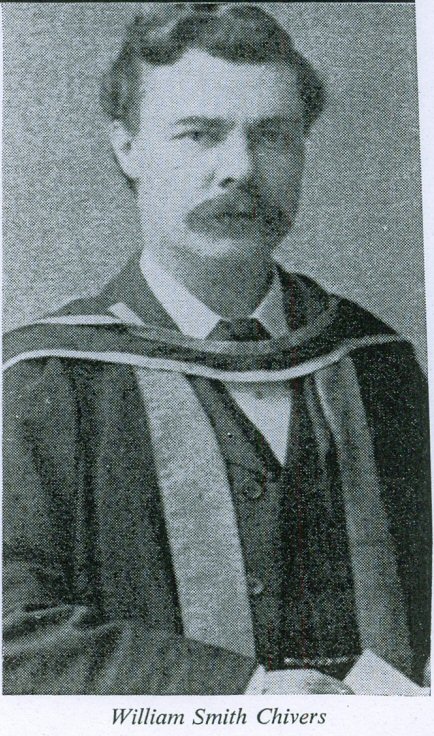
"Saving Chiver's School", 'Hampshire' magazine (p33), by Ronald E Gouge, August 1965
THE schoolboy's life in the last century was not an easy one. For example, when the O'Reilly brothers opened their school at Portsmouth in 1830 one of the great advantages they urged on parents"a distinguishing feature," they said - was that pupils were enabled to continue their studies uninterrupted: there were no vacations. Sixty years later, with the O'Reillys safely out of the way, life could still be hard. School started at 8 a.m., when the doors were closed. Latecomers were admitted at nine and greeted with six of the best. Primitive though this sounds today, the school thrived and its pupils prospered. It is remembered - as Chivers School or Esplanade House School -by hundreds of men in Portsmouth and far beyond with gratitude and affection. It is a remarkable measure of that feeling that the school could have gone into extinction this month, but it has been rescued by former pupils and parents of present-day boys. The story of the school begins with the brothers O'Reilly -William "from the University of Paris" and J., whose first name was never revealed in their advertising and literature. They set up their Academy at 66, St. George's Square, in 1830, announcing that they intended to unite with the ordinary studies pursued that of the French language, with the true Parisian accent, free of Extra Charge. On this, and the fact that there were no holidays, they appeared to rest their case.
We find them 10 years later, still uniting French language (with true Parisian accent) to the ordinary Classical and Mathematical studies pursued.
In that same year they moved to Esplanade House in Lion Terrace, where the school was to continue for some 40 years. `Repeated solicitations of several parents' had caused him to receive a limited number of Young Gentlemen as Boarders, William informs us.
By 1864 his dissemination of the French language with true Parisian accent had, it would seem, enabled him to make a slight alteration in his announcement: "The French language (avec I'accent de Paris) free of extra charge. "And, shape of things to come, Mr. O'Reilly had turned his attention to preparing pupils for Navy and Civil Service entrance examinations. But tragedy struck William O'Reilly in that year. His wife, whose job it was to look after boarders,
found the strain severe and had a mental breakdown. Boarders were given up, but this consideration only made poor Mrs. O'Reilly more anxious. Despite an attendant engaged from Dr. Window's private lunatic asylum in Fulham Road, the unhappy Mrs. O'Reilly drank from a bottle of Sir William Burnett's Disinfecting Fluid and died within a few hours.
Edward Bell, for 17 years Mr. Reilly's assistant, became principal for some nine years before, in 1873, the 30-year reign of John Smyth began. A giant physically, he was a notable character in Portsmouth affairs and did much good work for the Royal Portsmouth Hospital; he was known as a bluff but kindly man. He it was, who moved the school from Lion Terrace to 38, Green Road, Southsea.
Mr. William Smith Chivers had opened Chivers School, Abingdon Road, in 1881.
From the start of his career, Mr. Chivers, who had a sound science training, concentrated on preparing boys for Government examinations - at first for Customs and Excise, telegraph learners and the like, and later in the 1880s when the Civil Service Commissioners introduced entrance examinations for Dockyard Apprentices, he turned his attention to this field with remarkable success. His boys often gained first place from over 300 entries: they were rewarded with a sovereign, presented with due ceremony. Many went on to the most senior positions in Britain's Naval Dockyards. They worked hard: school began at 8 a.m., and the door was then barred. Latecomers were admitted at 9 a.m. and caned. School finished at 4 p.m., but on two days a week classes were held from 5 p.m. to 7 p.m. There was a Saturday class from 8 a.m. to 10 a.m.
But memories of pupils of the time are of a just man, of good humour.
He watched his boys carefully: if he thought one needed a break from his desk he would give him a blank postcard and tell him to get the postmaster at Cosham (about four miles away) to stamp it. He thus ensured that a boy he thought in need of exercise and fresh air received it.
At long last, in 1904, Mr. Chivers transferred his school to Esplanade House in Cottage Grove, taking over from John Smyth.
There it continued after Mr. Chivers'
retirement in 1918 -when his assistant, John Tribe, took over - until 1941, when incendiary bombs gutted the building. The school continued in St. Bartholomew's Hall, Southsea, under the headmastership of Mr. E. Ashton-Caine, a former second master. In 1959, after the death of Mr. Ashton-Caine, the school found further temporary premises at Queens Road under the guidance of Mr. W. Morcombe, who had been teaching at the school for nearly 40 years.
In latter years the school had achieved a good deal of success in preparing boys for officer cadetships in all three branches of the Services.
Recently the principals felt unable to continue the school and the Old Chivernians -an association of former pupils which was formed three "years ago -have, with the help of friends and the principals, formed a trust to keep the school going, to develop it and run it. Premises have been obtained at St. Mary's Institute, Fratton Road.
There the school will continue as a boys' public secondary school, with room for 120 boys.
Chivers has served its pupils well through the years, and through them the country: few schools can claim to have had such a proportion of its pupils in the service of the nation. With the cost of state education ever increasing, and with many parents still seeking a good and reasonable alternative, the courage and enthusiasm of those who have rallied to save Chivers will, no doubt, not go unmarked and unrewarded.
"Chivers-a school that was different" (Portsmouth) Evening News(p/s10-11),
by James Bayes Evening News 30th September 1966
Despite an heroic rescue bid by it s old boys, Chivers School, also known as Esplanade House School, will pass out of existence at the end of the current term, after 85 years of high scholastic achievement. This article is based on the memories of grateful former pupils.
Chivers, the school that was different."
William Smith Chivers - founded his school in 1881.
He ruled it with the heart, the brain and where necessary, the cane. The school motto was " Quae nocent docent which was translated for the benefit of the pupils as meaning -' What pains us trains us.
So you knew where you stood from the day you entered Chivers school.
You were there to work; you were there for Mr. Chivers make a success of you--and, your parents had the comforting knowledge that your education was not going to wreck their bank balance.
The fee at the original establishment in Abingdon Road, Southsea, was 1s... a week, plus 2d. a time for evening classes, held twice a week.
School started, at 8 a.m., at which hour the headmaster's deputy slammed and barred the door against latecomers.
According to a former pupil, this act was performed by the deputy because the headmaster himself was always late at that period. He lived at Cosham, and his train did not land him at Fratton Station till 8.10.
ONCE arrived, however Mr. Chivers lost no time. Mounting the platform in the big schoolroom, he faced his 120 pupils and commanded: "Stand!"
Every boy shot to his feet, and the headmaster then gave the order. "Eyes closed. The Lord's Prayer softly."
The prayer, having been murmured, Mr. Chivers, simply said, Sit."
Then he would snatch up his cane hold it at the ready and declaim; A strong reed, wielded by a strong arm, controlled by a strong mind works wonders."
With that he marched to the front door, unbarred it, and administered his "Royal Salute on the posterior of each latecomer as he scuttled inside.
Returning to the platform, Mr. Chivers would cry, " Now the homework!"
This was usually the signal for several boys to go up to his desk and ask questions about the work. It was a concession almost unheard of in the schools of that time, but Mr. Chivers was determined that his boys should have no excuse for being fogged.
During these interludes the atmosphere became relaxed, and one former pupil recalls that the headmaster was not averse to a short discussion on the county cricket scores.
Then suddenly, Mr, Chivers would jerk out his watch and exclaim: "Ten o clock - and nothing done! Get to work!
The boys fled as their mentor sprang up, brandishing his came, and pursuing theme back to their desks.
DOWN went the pupils' noses, And as their pens scratched they talked-freely and loudly.
But the difference between Chivers and other schools was that talking in class" was not idle matter. The boys were discussing their work.
The headmaster let them carry on till the din became so terrific that he would thunder: Silence!"
Immediately, as a veteran Old Chivernian recalls, "there was s silenter silence than there had ever been in any school."
Then, with the attention of the entire school riveted on him, Mr, Chivers would fire test questions right, left and centre to boys selected at random.
Having made this lighting check, the headmaster would say, "Carry On, then'' and within minutes the uproar was in full spate again.
It was a system that would have appalled the conventional educationist of the period but the honours list at Chivers School proved that it worked.
THE virtues of homework were highly rated at Chivers, and many a conscientious pupil slogged far into the night on his overtime."
If his labours got him under the weather, however, this was quickly detected by the headmaster and a remedy was applied.
The boy would he summoned from his desk and with a blank postcard with the order to get It stamped by the postmaster at Cosham some four miles away and bring it back to school.
This ensured that the boy got the fair and exercise needed to bring the colour back to his
cheeks.
DURING World War I, a cadet company was formed at Chivers, the headmaster was invested with the rank of captain.
He was delighted when the contingent was given the designation of "O" Company. It was in keeping with the school's tradition, he told his boys because O" must stand for an "all-round company."
Thorough in all things, Mr. Chivers applied himself seriously to his new duties as a military officer.
As school work proceeded, he sat at his desk doing his own swotting over the Amy drill manual.
Then to nuke sure that his contingent came up to scratch, he went to the expense of hiring a drill sergeant from Eastney Barracks to put the boys through their paces.
Expectations ran high when it was announced that a review of cadets was to be held at the
Connaught Drill Hall, with the Duke of Connaught himself, as the inspecting officer.
The rumour ran round the school that the headmaster was to accompany the Duke on his inspection and that would be mounted on a charger.
The bottom fell out of many a boy's world when nothing of the sort happened
In the school s early days Mr. Chivers taught the senior boys and committed the instruction of the younger element to a ginger haired lad of 17 known "Josser Tribe.
"Josser", proved a thoroughly capable teacher. On becoming established
he grew himself a bristling moustache to match that dignity, and eventually he became the headmaster's official deputy.
Disaster at the school concert
When Mr Chivers retired in 1920, Josser " succeeded him. By that time the school was established at Esplanade House, Cottage Grove to which building it had been moved in 1904.DURING the period at Cottage Grove, the teaching of physics was shared by two masters, Mr. French and Mr. Bedford, and the boys delighted in playing off the one against the other. The unfortunate teachers endured this till the memorable day when Mr. Bedford seized the opportunity to confront the tormentors with the moment of truth. The chance came when he was outlining Archimedes ' Principle. He was interrupted when a hand shot up and the owner protested, "Please sir, that's wrong. Mr. French told us that when an object is immersed in water it loses all its weight." Mr. Bedford replied that there must be some misunderstanding, and that what he had said was right. A dissentient murmur ran' round the class. It was implied mutiny in the face of learning but Mr. Bedford kept his composure. "Very well, then," he said, "Let us conduct an experiment, He jabbed a finger at one of the boys. "You," he commanded," go and get a bucket of water." The boy obeyed. He was then directed to remove his shoes and stockings and place his feet in the water. This having been done, Mr: Bedford yanked a massive weight, from the mechanics cupboard, held it over the bucket, and announced "I am now going to drop this weight into the bucket of water. You need have no fear that it will do any damage to Blank's feet because you all know that this lump of iron will have lost all its weight once it is dropped into water," Needless to add, the weight did not drop but the "penny" did with the class and from that time Messrs Bedford and French suffered no more torment.
CHEATING was regarded as one of the worst crimes on the school calendar qualifying automatically for six of the best.
Greatly daring, therefore, were the boys who clubbed together to buy arithmetic "answers" book.
It cost them only 1s. 6d, and for a long time it seemed a most rewarding investment.
One morning the homework check-up revealed, that they were the only b: s in' the class who had come up with the answer given in the book m respect of a certain sum.
But their complacent smiles faded as Mr Tribe was observed to be glaring at their exercise books, his moustache bristling even more than usual.
They were soon made aware of the awful explanation in Mr. Tribe's copy of the book the answer had been deleted, and other figures pencilled in the margin. The book's 'only' misprint had been detected by Josser" years previously.
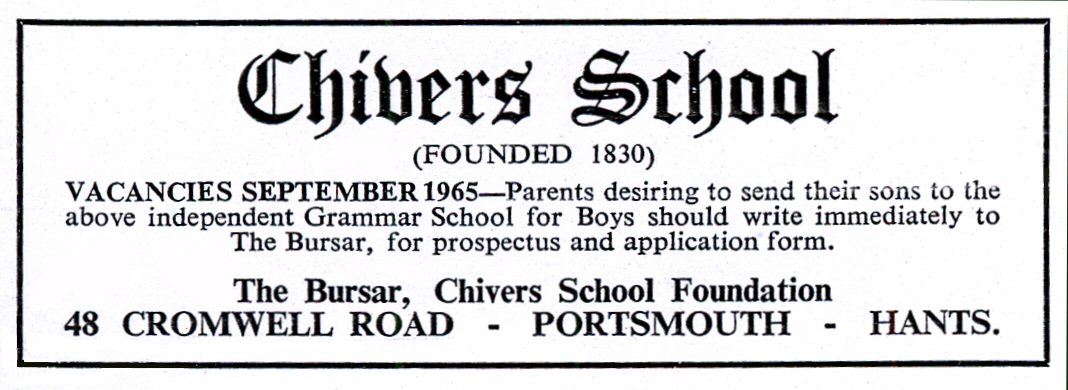
OUT of school hours, Mr. Tribe relaxed with his violin, which was a remarkably fine instrument.
One Christmas period when making preparation for the school's annual concert he discovered that a boy named Thomas showed distinct promise with the bow.
"You must give a solo," he told the lad. "But you will need something better than your violin. I will lend you my own."
The news that "Josser had loaned his treasured instrument spread throughout the school, and on the day of the concert all, the boys were agog. Young Thomas duly mounted the platform. But before he had scraped half a dozen bars everyone was wincing, and Mr. Tribe's face was crimson.
"Josser had forgotten to tune his celebrated violin.
MR. TRIBE reigned at Chivers till 1941, in which year incendiary bombs destroyed the Cottage Grove building,
He was succeeded by Mr. E. Ashton-Caine, who steered the school through difficult years in temporary premises at St. Bartholomew's Hall, Southsea.
In 1959, after the death of Mr. Ashton-Caine, the school moved to Queen's Road under the head-mastership of Mr. W. Morcombe, who had been teaching at Chivers for almost 40 years.
One more move saw the school finally settled at St Mary's Institute, Fratton Road. At those premises there was room for 120 boys but, perhaps because of the development of the State grammar schools, the pupil intake dwindled as the years passed by.
Today, there are only 19 boys on the roll at Chivers. Before the last war, the school mustered 300.
When William Smith Chivers died in 1932 his foundation was regarded as being on a par with Portsmouth Grammar School, and he was mourned by hundreds of old boys who had risen to high positions in life thanks to the education they had received at Chivers.
There were many other mourners, for Mr Chivers was a generous giver of his talents.
Even when he was still running his own school he served the wider public need as a member of Portsmouth Education Committee;
In 1932, he was appointed Chairman of a special sub-committee charged with developing the Evening Institutes. Within four years, the number of "student hours" at those establishments had
shot up from 147,000 to 188,000.
There you have it. If results were needed in the field of education, one man for the job was William Smith Chivers.
The writer particularly indented to Mr. Ronald Gouge Chairman of the Governors of Chivers and an old boy, for the loan of many written reminiscences of former pupils.
William Smith CHIVERS
Births Jun 1862 CHIVERS William Smith Portsea 2b 394 |
ERNEST ASHTON CAINE LCP, FRSA(Fellow of the Royal Society of Arts), MRIPHH (Royal Institute of Public Health and Hygiene), MRIPHH
ERNEST ASHTON CAINE served in the first world war and his service cor number was reg no 2104
1881 census
Dwelling: Carlisle Rd 9 Hampstead Ter Census Place: Portsea, Hampshire, England
1891 census RG12 874 page 127
Marriages Sep 1850 CANE Jabez EASTMOND Ellen Basingstoke 7 85
Births Sep 1852 CAINE James Edmund Portsea 2b 345
Marriages Mar 1883 CAINE James Edmund ASHTON Ad le Albertine C Portsea 2b 683
Births Jun 1886 CAINE Ernest Ashton Portsea 2b 513
Births Sep 1932 CAINE Alan mothers maiden name EVANS Liverpool 8b 108??????????
ERNEST A CAINE DIED AGE 72 PORTSMOUTH 6B 653 26th January 1959
Kellys Directory1929-30 Kellys Directory Mr Ernest Ashton-Caine, 55, Chelsea Road, Southsea.
1931-32 Kellys Directory
Mr Ernest Ashton-Caine, 55, Chelsea Road, Southsea.
1933-34 elect reg
Mr Ernest Ashton-Caine, 55, Chelsea Road, Southsea.
Irene Olivia Vivien Caine
Daisy Florence Pearce
Caroline Cooper
1934-35 Kellys Directory
Mr Ernest Ashton-Caine, LCP MRIPHH, 55, Chelsea Road, Southsea
1949 Elect Reg
Mr Ernest Ashton-Caine, 55, Chelsea Road, Southsea.
Irene Olivia Vivien Caine
Margaret J E Evans
1951 Kellys Directory
Mr Ernest Ashton-Caine, LCP MRIPHH, 55, Chelsea Road, Southsea
Rinka Ivanova Dancing School
1953 Kellys Rinka Ivanova 55 Chelsea Road
1956 Kellys Rinka Ivanova 55 Chelsea Road
1958 Kellys Directory
Mr/Mrs Ernest Ashton-Caine, LCP MRIPHH, 55, Chelsea Road, Southsea
1957 Elect Reg
Mr Ernest Ashton-Caine, 55, Chelsea Road, Southsea.
Irene Olivia Vivien Caine,
Margaret J E Evans,
Florence A Preston
Deaths Mar 1959 CAINE Ernest A 72 Portsmouth 6b 653
1960 Kellys Directory
Mrs Ashton-Caine, 55 Chelsea Road, Southsea
1960 Elect Reg
Mr Ernest Ashton-Caine, 55, Chelsea Road, Southsea.
Irene Olivia Vivien Caine,
Margaret J E Evans,
Florence A Preston
1961 Elect Reg
55, Chelsea Road, Southsea.
Irene Olivia Vivien Caine,
Margaret J E Evans
1962 Elect Reg
55, Chelsea Road, Southsea.
Irene Olivia Vivien Caine,
Margaret J E Evans
1963 elact reg
55, Chelsea Road, Southsea.
Irene Olivia Vivien Caine
1964 Kellys Directory
55, Chelsea Road, Southsea.
Mrs Ashton-Caine, 55 Chelsea Road, Southsea
1964 elact reg
55, Chelsea Road, Southsea.
Irene Olivia Vivien Caine
1965 elact reg
55, Chelsea Road, Southsea.
Irene Olivia Vivien Caine
1966 NIL
1967 Kellys Mrs Caine 35 Chetwynd Road & 19 Inglis Road.
He was a staunch Conservative (Havelock ward) and historian who supported the Cavaliers, hated socialism, served in the Army Service Corps in WW1 as an Acting Sergeant. His father worked in the dockyard and his mother was a Professor of Languages. During WW2 he was Principal of the Esplanade Home School. He lived in Lowcay Road in the 1920s and Chelsea Road in the 1950s. A Mrs Rinka Ashton Caine was a great dog-lover and had a prize-winning Pekinese.
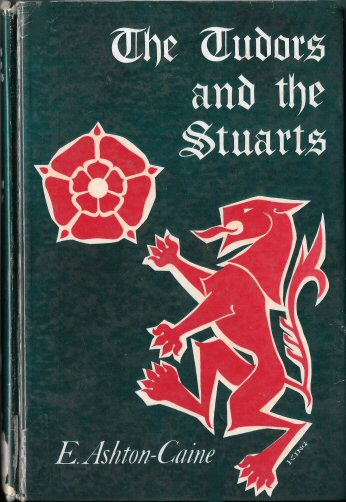
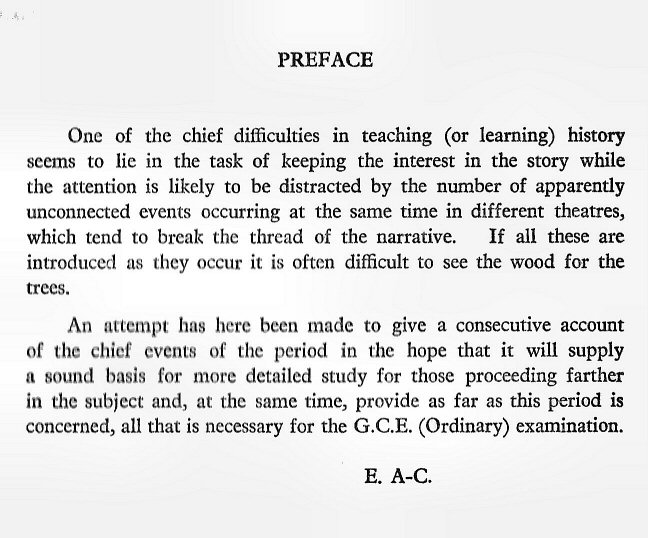

The first edition of his book is dated 1960, he died 26th January 1959 |
William George MORCOMBE
Births Dec 1901 MORCOMBE William George Portsmouth 2b 453
Births Mar 1896 Morcombe Ethel Clara Holborn 1b 665 When Chivers closed its doors William Morgan began teaching at Mile End House School. They called him Basher Bill, but it was said "what a lovely, kind and considerate man he was."
|
The Re-Union
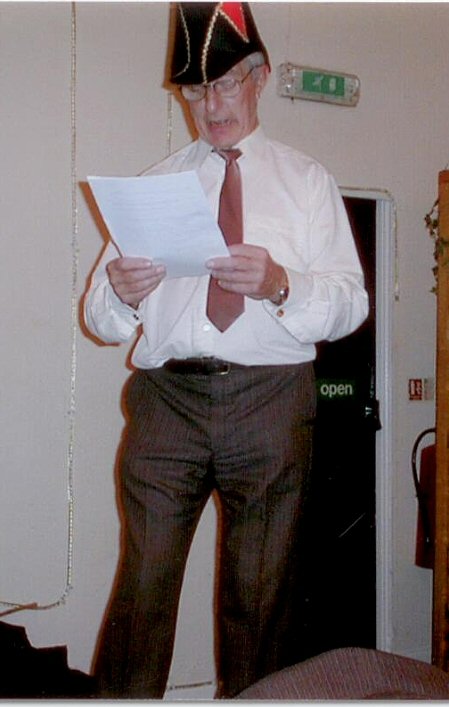
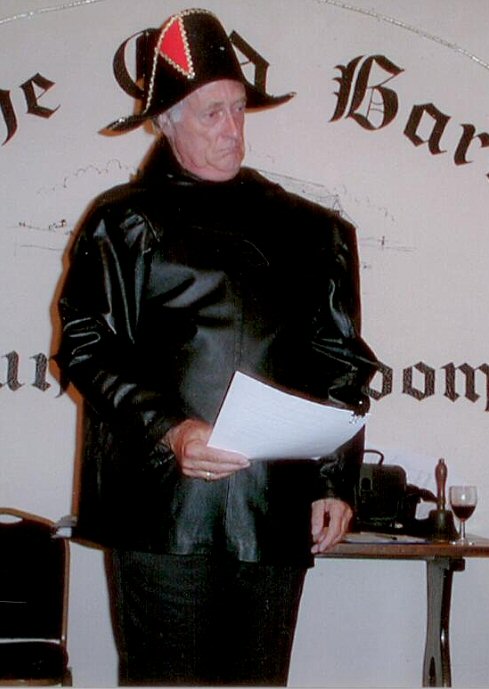
A Re-Union was held on Saturday 23rd April 2005 at the Mead End Inn, at Denmead near Portsmouth and a good time had by all, numbering around 50 old boys.
Brain Wells and David Flux provided a little light entertainment, by reading a signal to and from Nelson at the Battle of Trafalgar. A meal was had and guests tried to decide who was who.
Some of the 'Old Boys'
Sir Thomas Arthur BramsdonSir Thomas Arthur Bramsdon (27 February 1857 29 September 1935)was a British solicitor from Portsmouth and a Liberal Party politician who was elected for four non-consecutive terms as a Member of Parliament (MP) for Portsmouth constituencies.Bramsdon was born in the Portsea Portsmouth, the son of John and Emma Bramsdon. In the 1861 Census his father was described as a retail brewer living at 40 Hertford Street, Portsea and Thomas is listed as a four-year-old Scholar. In the 1871 Census Bramsdon is living with his widowed mother at 350 Commercial Road, Portsea and is described as a 14-year-old Solicitors clerk.[4] Bramsdon was educated at Esplanade House School, in Portsmouth, and admitted as a solicitor in 1878, practising in the local firm of Bramsdon and Childs.
Douglas OrsmondDouglas Orsmond was born on the 17th February 1920, in Gosport. His father was a Shipwright, before setting up his own business as a builder. At 11, his uncle paid for him to go to a private school in Portsmouth, Southsea Esplanade House school, known as Chivers and he caught the Gosport Ferry each day. School was 5 days a week, plus a half day Saturday and two evenings a week, with homework each night.At 16 years old, he sat his exams and after long chats with his father decided to join the RAF as an apprentice studying radio and electrical engineering. He was based at Cranwell in Lincolnshire for 3 years. On leaving the RAF, Doug took a job with EMI based in Hayes in Middlesex. After a year, and with no promotion in sight, he left EMI and joined the Admiralty at ASWE, based in Portsmouth. After lodging in a flat in Southsea for a while, he and Vera bought a plot of land in Waterlooville and engaged a builder to have a bungalow built which he designed, finally moving in in August of 1953, with hardly any money left. In 1967 he joined the Freemasons which as he admitted gave him a wider perspective on life and in 1976 also became a governor at Elizabeth Road school in Waterlooville, quickly becoming Head Governor a post he held until 2001. He retired from the Admiralty in 1982, when cuts were made to the Civil Service and after a couple of years joined the Civil Service Retirement Fellowship, and became their Social Secretary. Douglas had an amazing spirit, keeping active with the Retirement Fellowship, joining the Over 55 s club regularly playing indoor bowls, darts and chess Mark says he was a mean chess player that he never beat whenever they played. It is difficult to summarise a life of 93 years, but Mark & Helen are thankful for his long, happy and fulfilling life. Douglas is now at peace and has joined his beloved Vera, in the presence of God.
Robert BarnesRobert was the son of Joseph Barnes and Eliza Bydder born on the 25th of April 1846 in Portsea Island, Hampshire England. Robert attended Esplanade House School AKA Chivers College in Portsmouth, Hampshire. Where he was known for his interests in athletics and football. Robert worked for Barnes & Son the family decorating business started by his father Joseph in 1837. By 1861 Robert was managing the company.Robert was also a director of Brickwood and Co Ltd. 1882, 1885-1890 Councillor for St Mary 1892 Mayor of Portsmouth 1893-1895 Alderman for St Jude 1896-1910 Alderman for St Mary
During Robert's tenure as Mayor he over saw the liquidation of the Portsea Island Building Society being appointed "Honourary Assessor" by Lord MacNaughten. When HMS Victoria was sunk on 22 June 1893 Robert started a relief fund which lead to him being appointed a member of the Royal Patriotic Commission. During this year Robert was elevated to the Aldermanic bench and made a Justice of the Peace.
Robert John (Bob) WeedonRobert John (Bob) Weedon (1928-2007)We report with great sadness that Bob Weedon passed away on 31st May 2007 aged 78. Bob Weedon was born at Southsea on 18th August 1928 and educated at Esplanade House School. He passed the April 1944 Civil Service Open Entry Examination and joined Anson Division at RNATE (later HMS Fisgard) at Torpoint in Cornwall on 2nd August 1944 as an Engine-Room Artificer Apprentice. Bob was a popular, ebullient and larger App RJ Weedon 1948 than life member of the last class to complete four years training at the Artificers' Training Establishment at Torpoint. On passing-out from HMS Fisgard on 12th August 1948 he joined the Fleet Carrier HMS Implacable as an ERA 5th Class for the fifth year of his training, at the end of which was rated Acting ERA 4th Class (Petty-Officer). The following year he joined the frigate HMS Loch Tralaig serving in the Londonderry Flotilla. Whilst travelling on the ferry from Larne to Stranraer to spend his leave at home, he met a pretty Wren, also from Portsmouth and a follow-up telephone call was to lead to a life-long romance with his future wife Margaret. In 1951 Bob was drafted to HMS Dolphin at Gosport and on the 16th February 1952 he and Margaret were married at the Church of the Ascension, North End Portsmouth.
George Pincott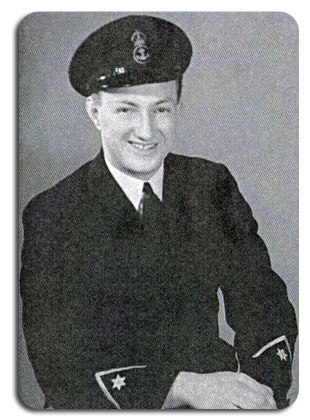
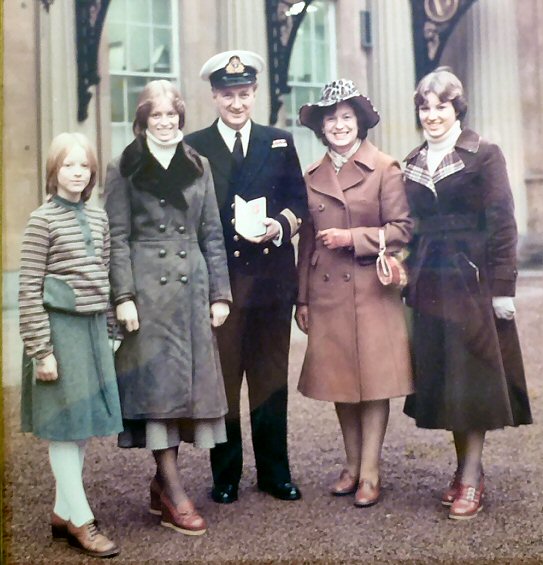
George Lt Cdr MBE Pincott : Obituary Published in the Portsmouth News on 14 January 2013 PINCOTT George Lt Cdr MBE Passed away peacefully on January 5, 2013, at home, aged 85 years. Much loved husband, father and grandfather. Funeral service will take place at Portchester Crematorium on Friday, January 25 at 12.30 p.m. and afterwards we will celebrate his life at Fort Nelson, Portsdown Hill Road, Fareham, PO17 6AN. All family and friends are welcome. Family flowers only but donations, if desired to The Rowans Hospice Purbrook Heath Road Purbrook, PO7 5RU. 023 9225 0001 Any enquires to M Coghlan Ltd 01329 282711 Born in Southsea in 1927 and joined Chivers age 11 in 1938 and left in 1943 age 16 His father ran pub The Spector in Joseph Street Gosport and the lived at 41 Avenue Road Gosport and at Emsworth. He joined the Royal Navy in 1943 and was an accomplished swimmer/diver. George participate in the Command Championships annually and did reasonably well. He was also in the Church Choir but that was more to do with getting an extra days leave than his fondness for choral music. In his final term at HMS Fisgard George was the Senior Chief Petty Officer Apprentice equivalent to head boy in a public School, a job he in which he shone. At the end of our four years together George returned to the Portsmouth area where after courses he served in HMS Theseus and in 1950 he went to Exbury House in the New Forest as a preliminary Upper Yardman. After further sea time in HM Ships Comus and Sirius, on 15 August 1955 he was promoted to Acting Commissioned Ordnance Engineer. On completion of about twelve months of courses George did a spell in Whale Island and a period in the stores Depot at Dinton, near Salisbury. George loved Whale Island. In 1960, now a Lieutenant and serving in HMS Lincoln, his life was about to change. He met the Petty Officer Wren from the Film Library in Devonport. They did eventually become friendly. She would drop him off at Fareham station on Friday night and pick him up for the return trip on Sunday. It obviously got more serious and George married Linda in 1961 and were blessed with three daughters, Alison, Mary and Janet. In 1965 he was with Western Fleet Technical Staff as a trouble shooter in HMS Delight. George then stood by the build of, and served in, HMS Hampshire after which he was promoted to Lieutenant Commander before doing a spell with DGW(N) and two jobs in Collingwood. The first as Senior Divisional Officer in the Apprentices Section, where I was one of the other Divisional Officers and then as Deputy Head of the Control Engineering School. His ability to deal with young people in a way which got the best out of them was invaluable. Towards the end of his time in the Service he was appointed to the Naval Overseeing group at Vospers Yard in Woolston. He was also made a Member of the Most Noble Order of the British Empire for what could only be described as outstanding service. George left the Service 1977 at the age of 50 after 34 years service. He worked on short term contracts for Vospers, and spent many holidays driving the caravan with family down into France and he was introduced to cruising. He had always been very keen on photography and n retirement, he also Joined several local camera club, including the Portsmouth Camera Club. He died 5th January 2013 age 85, George was such a lovely man. |
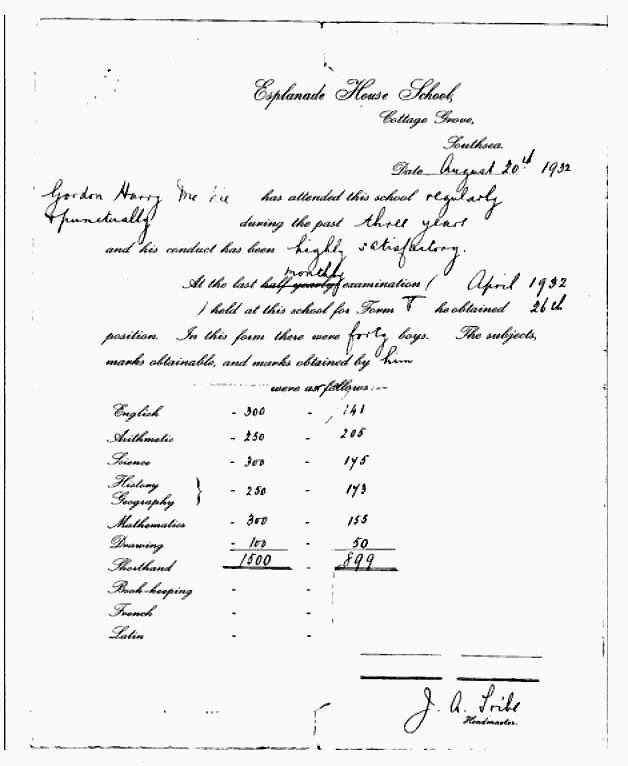
Barry McNie found an old school report from 1932 belonging to his late father Gordon when he attended Esplanade House School, Southsea in Cottage Grove and the headmaster at that time was John Tribe. |
